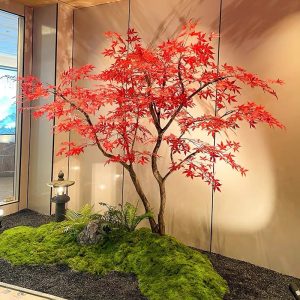With over a decade in the artificial plant industry, I have observed how artificial trees can transform landscape projects. Unlike natural vegetation, artificial trees provide long-lasting aesthetics, reduce maintenance costs, and promote environmental sustainability. This article offers real-world data, multi-environment case studies, and professional guidance for landscape designers, developers, and facility managers.
Why Artificial Trees Are Becoming Essential in Modern Landscaping
Natural trees require constant watering, fertilization, and pruning, resulting in high operational costs. Artificial trees offer measurable advantages that improve both aesthetics and efficiency:
1. Cost Efficiency and Return on Investment
In a Shanghai urban park project (2023), replacing natural trees with artificial trees reduced annual maintenance costs by 60%, allowing the budget to fund playgrounds, seating areas, and pathways.
| Tree Type | 5-Year Maintenance Cost (USD) | Notes |
|---|---|---|
| Natural Tree | 16,500 | Irrigation, pruning, fertilizer required |
| Artificial Tree | 6,500 | Occasional cleaning only |
The global artificial greenery market was valued at USD 1.06 billion in 2024, projected to reach USD 1.49 billion by 2032 with a CAGR of 4.4% (Databridge Market Research).

2. Resilience Across Extreme Environments
Artificial trees remain visually vibrant where natural trees struggle. Coastal resorts, desert parks, and mountainous landscapes demonstrate resilience against storms, high salinity, and drought, providing consistent greenery year-round.
3. Realism and Immediate Visual Impact
High-quality artificial trees replicate natural forms, leaf textures, and trunk structures so convincingly that visitors often cannot distinguish them from live trees. They provide instant greenery, enhancing spatial depth and seasonal aesthetics.
4. Environmental Sustainability
In a residential development, artificial trees reduced irrigation by 18%, eliminated pesticide use, and lowered energy consumption (arxiv.org). Many artificial trees are constructed from recyclable materials, reducing the ecological footprint of landscaping projects.

Applications Across Landscape Types
- Urban Parks & Public Spaces – Deliver shade, visual appeal, and low-maintenance greenery for high-traffic areas.
- Residential & Commercial Developments – Rapidly improve landscape quality while reducing maintenance efforts.
- Challenging Environments – Ideal for deserts, mountains, and coastal zones where natural trees cannot thrive.
Design and Manufacturing Guidelines
- Seamless Integration – Color, leaf pattern, and branch structure should harmonize with surrounding landscapes.
- Durable Materials – PE (polyethylene), PVC, fiberglass provide UV resistance, waterproofing, and long-term durability.
- Advanced Craftsmanship – 3D printing, hand carving, and mechanical assembly enhance realism and structural stability.
- Case Study – In Shanghai’s Jing’an District (2022), 20 artificial maple trees (6 meters tall, PE + UV coating) were installed in 6 hours, reducing projected maintenance costs by 40% and improving visitor satisfaction.
Installation and Maintenance Best Practices
- Installation: Level the ground and secure weighted bases for stability.
- Maintenance: Minimal; occasional cleaning suffices.
- Cost Comparison: Annual upkeep for artificial trees: $250–350, versus $1,600–1,700 for natural trees (dfwturf.com).
Environmental Contributions
- Preservation of Forests & Habitats – Reduces reliance on natural trees.
- Water and Energy Savings – Eliminates irrigation and chemical inputs.
- Eco-Friendly Materials – Recyclable artificial trees minimize environmental impact.
Emerging Trends and Industry Challenges
Artificial trees are evolving into smart, multifunctional, ultra-realistic designs, including adjustable branches, integrated lighting, and environmental sensors. Balancing cost, visual appeal, and durability remains essential. The market is projected to grow at 8% CAGR, reflecting increased adoption across commercial, residential, and public projects (HTF Market Insights).
Recommendations for Landscape Professionals
- Assess site-specific environmental conditions before selecting artificial trees.
- Choose materials and designs that balance realism, durability, and cost-effectiveness.
- Explore smart greenery technologies for enhanced functionality.
- Evaluate exposure to extreme weather, sunlight, and wind.
- Collect stakeholder feedback and monitor maintenance outcomes to refine future projects.
Conclusion
Incorporating artificial trees ensures lasting aesthetics, cost efficiency, and environmental sustainability in landscape projects. By leveraging data-driven insights, professional expertise, and innovative designs, landscapes achieve sustainable beauty, operational efficiency, and improved visitor experiences.











